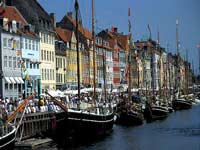 Getting Around CopenhagenCopenhagen''s public transport is exceptionally safe, reliable,
clean and inexpensive. The Metro, buses and trains in the city and
surrounds operate on a one-fare system, where tickets are valid for
all three types of transport with no extra cost for transfer.
Services are frequent between 5am and 12.30am, with several night
buses operating from the City Hall Square to the suburbs in
between. On Friday and Saturday the Metro runs all night. The Metro
runs from Vanlose Station to Lergravsparken in East Amager, to
Orestad in West Amager and to Frederiksberg. Buses are yellow and
bus stop clearly marked with matching yellow signs. Tourists are
advised to obtain the ''Copenhagen Card'', which offers free
transport and free entry to most major attractions in the city. A
favourite mode of transport for locals and visitors is the bicycle,
and Copenhagen has cycle paths and routes along all major streets.
Free bicycles are provided between May and September in a series of
Bike Parks where it is possible to deposit a coin, obtain the use
of a bicycle, drop it off at another park later and retrieve the
deposit. For good quality bike-rentals, visit Baisikeli bicycle
shop in Tursensgade; a benevolent company using the proceeds to
benefit the poor in Africa, shipping second-hand bikes overseas
regularly. So, roam the streets on a rented bike feeling inspired,
energised and kind. Copenhagen is well supplied with licensed
taxis, operated by five different companies. Taxis display a
lighted sign when they are for hire, and can be flagged down
anywhere. Cycle taxis, similar to the rickshaws operating in the
Far East, have also been introduced and are popular with visitors.
Traffic is usually congested in the city centre and a car can be a
liability rather than an asset. The city has a complicated
colour-coded zone pay parking system in operation during business
hours. |